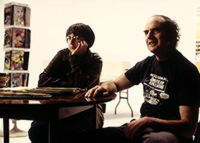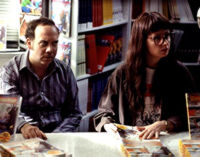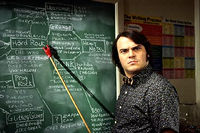“Billy Crystal’s welcome to come to New Zealand and make a film any time he wants” — Peter Jackson, director, “Lord of the Rings: Return of the King.” Winner of best picture, best director, best adapted screenplay, best song, best art direction, costume design, makeup, score, sound mixing, visual effects.
A telling omission: none of the acting awards went to “Rings.”
###
Best pic has to be “Rings.” How can it walk off w/everything else and not win? Near as I can tell it won in every category it was nominated in.
###
Best actor: Tough choice. i’m thinking Ben Kingsley. Oops, Sean Penn.
Must be the make-up Oscar for being passed over on “Dead Man Walking.” Classy speech for a reputed bad boy.
###
Best actress: Charlize Theron gets the nod. God, these women are all hsyterical.
What a tan she has. Charlize, give it up, girl!
###
Tom Cruise gets to give one away but never gets one himself. Wow, he seems to have shaved for the first time since 1999. Best director: why even name anybody besides Peter Jackson?
###
Hey, it’s the Tim and Susan show. For some reason I knew it was going to be Sofia Coppola for original screenplay. Any question that the Coppolas are a film dynasty?
###
The Coppolas. Sofia’s on drugs, I swear. I’m rooting for “American Splendor” for best adapted screenplay but alas, it’s “Rings” again. Peter looks like Belushi with a beard.
###
Three hours and counting. Lordy.
###
Cinematography: Might as well give it to “Rings.” Wait, it’s not even nominated. “Master & Commander” takes it. A well-photographed film. The DP sounded a bit blotto.
###
Charlize: Is she as beautiful as Catherine Zeta-Jones? Melissa gives the nod to Z-J. Best foreign-language film winner: “We’re so thankful Lord of the Rings did not qualify in this category.”
###
Wow: Jack Black is really short. This “you’re boring” bit is pretty funny — the real “best song.” “Rings” taking another statuette makes me want to gag, though it’s good to see Annie Lennox up there.
###
Woo-hoo, it’s Mitch and Mickey from “A Mighty Wind.” Won’t win but it should. A rare outbreak of humor from the Academy. The Kiss: A hoot in any language.
Hmm, this French song is pretty entertaining. Those “Cold Mountain” songs are seeming stronger than ever.
###
“People are moving to New Zealand just to be thanked.”
###
Editing: A topic dear to my heart. Might as well be “Rings” again. How about we just give all the rest to “Rings” and we can all go home?
###
Best score: “Rings” again. They’re going have to start thanking people in Papua New Guinea next. Suggestion for future years: Couldn’t they do the thank yous in private? Think how much more meaningful it would be.
###
Not many categories left. Thank God.
###
Gregory Peck: From Atticus Finch to Dr. Mengele. RIP.
###
Best documentary: “Fog of War,” Errol Morris’ first win. Haven’t seen it, wonder if he’s getting it more for his career. “I fear we’re going down a rabbit hole once again.” Billy: “I can’t wait for his tax audit.”
###
Kate Hepburn. True classic. A great one has to die so they can show some real entertainment on Oscar night.
###
“It’s official, there’s now nobody left in New Zealand to thank.”
###
Do I give a flip whose sound mixing was best? Take a guess. I thought it might go to “Master & Commander,” which had wonderful sound. But no: another “Rings” win. This is getting tedious. Now, clue me in: why a separate Oscar for editing and mixing? Hey, Master & Commander wins sound editing — see, I was half right.
###
Almost two hours in … my butt’s getting tired. circulation in my legs is going. Good thing this laptop is so warm.
###
Best Makeup: Another “Rings” lock? Well, that was a surprise.
###
Inspector Clouseau! “That’s a Priceless Steinway.” “Not anymore.” Blake Edwards looks 300 years old. All that hard Hollywood living.
###
Jennifer Garner’s dress: impressive. Safe bet the stars are all sneaking out for bathroom breaks about now.
###
Visual effects: Another “Rings” lock. (Note Will & Jada, the odd Hollywood combination of tall man and short woman.)
###
Three songs in and no crap to be found. Amazing.
Annie Lennox sings the “Rings” song. Not bad, but not the equal of the Krauss songs.
Alison Krauss — haunting voice, haunting tune. Probably too gloomy to win. Wow, two songs from the same movie, Cold Mountain. Nice showcase for Krauss — it’ll be a crime if her songs don’t win.
###
Liv: Lose those glasses.
###
Best live-action short: (where’s Danny DeVito?) “Two Soldiers.” Best animated short: “Harvie Krumpet.”
I wonder how many people have seen these movies and if they could fill a city bus. The Starsky/Hutch thing was mildly amusing.
###
Bob Hope’s best “I didn’t get it” gags: “Or as it’s called around my house.. Passover”; “Or, as it’s called around my house: The Fugitive.” OK, it’s funnier when he says it.
###
Best supporting actress: Another impossible name… I’m guessing nobody portraying an Iranian will win, though. Ooh, Renee’s back up there again. Kind of an embarrassment to be taking it for best-supporting …. I mean, she’s a major star and everything. But it’s one more Oscar than Tom Cruise has gotten. How’s that for justice?
###
Costume design: “Rings” again. You’d get one too if you had to find costumes for all those orcs. (Renee: it looks like you’ve had a boob job!).
###
Best animated feature: “Finding Nemo” is a lock. Robin Williams needs to turn it off for once. The guy telling his wife he loves her in front of a billion people was a nice touch.
###
Production designer: (Angelina, we can see your nippies!). Goes to “Return of the King.” Pretty much a slam dunk. I was rooting for “Master & Commander,” because it was one of the first movies in which I actually made an effort to find out who the production director was. But the “Rings” stuff is so colossal in scale, no shame in losing out to it.
###
Best male supporting: (C. Zeta-Jones: too gorgeous for her own good). I hope it goes to somebody whose name I can spell. Tim Robbins! Cool. All the others are better actors, of course. The crowd holds its breath as Tim says, “I’ve got just one more thing to say.” Sighs of relief as he tells abuse survivors to get help.
###
He’s really going to keep this up for all five best-picture nominees. For once the rich, beautiful people of the movie industry pay the price of fame: no way to avoid Billy’s opening sequence. Please, bring on the awards for technical merit.
###
Make him stop… Billy’s singing again. He’s got some nerve telling Clint Eastwood not to sing again.
###
Cool, Michael Moore just got squished.
###
Naked Billy Crystal. Scary.
###
Opening sequence: Sean Connery being stentorian.


 The real Harvey Pekar and his wife, Joyce
The real Harvey Pekar and his wife, Joyce
 Paul Giamatti and Hope Davis as Harvey and Joyce.
Paul Giamatti and Hope Davis as Harvey and Joyce.  There are no girls of any consequence in "Master & Commander: The Far Side of the World." This is a movie about men and ships, duty and obsession, combat and killing, luck and leadership — pure guy stuff from stem to stern. Russell Crowe and his cast of unknowns are fighting men (and boys) with two enemies: a seemingly unsinkable French frigate and the always implacable sea. Director Peter Weir of "Truman Show" and "Year of Living Dangerously" fame should have added a third enemy — fear — but this is a tale of gallantry so there isn’t much wallowing in weakness.
There are no girls of any consequence in "Master & Commander: The Far Side of the World." This is a movie about men and ships, duty and obsession, combat and killing, luck and leadership — pure guy stuff from stem to stern. Russell Crowe and his cast of unknowns are fighting men (and boys) with two enemies: a seemingly unsinkable French frigate and the always implacable sea. Director Peter Weir of "Truman Show" and "Year of Living Dangerously" fame should have added a third enemy — fear — but this is a tale of gallantry so there isn’t much wallowing in weakness.  Finally, there is because at long last he’s in a movie whose a) subject is Rock ‘n’ Roll; b) director is Richard Linklater (“Dazed & Confused”) and c) supporting cast includes a rockin’ bunch of kids who come within a drumstick’s width of upstaging him.
Finally, there is because at long last he’s in a movie whose a) subject is Rock ‘n’ Roll; b) director is Richard Linklater (“Dazed & Confused”) and c) supporting cast includes a rockin’ bunch of kids who come within a drumstick’s width of upstaging him.